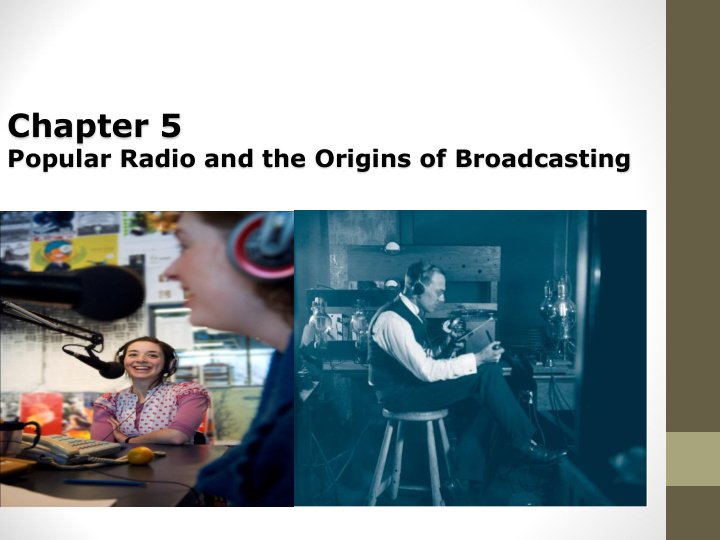



Chapter 5 Popular Radio and the Origins of Broadcasting
• As a medium for mass communication, radio broadcasts offered the possibility of sending voice and music to thousands of people. • broadcasting: the transmission of radio waves or TV signals to a broad public audience.
• In 1921, the U.S. Commerce Department officially licensed five radio stations for operation; by early 1923, more than six hundred commercial and noncommercial stations were operating. • By the end of 1923, as many as 550,000 radio receivers, most manufactured by GE and Westinghouse, had been sold for about $55 each. • By 1925, 5.5 million radio sets were in use across America, and radio was a mass medium.
Excerpt from Radio History A Vision of Radio
In 1923, when AT&T aired a By the end of 1924, AT&T had program simultaneously on its interconnected twenty-two flagship WEAF station and on stations in order to air a talk WNAC in Boston, the phone by President Calvin Coolidge. company created the first Some of these stations were network owned by AT&T, but most simply consented to become network: a broadcast process AT&T “affiliates,” agreeing to that links, through special air the phone company’s phone lines or satellite programs. transmissions, groups of radio or TV stations that share These network stations programming produced at a informally became known as central location. the telephone group and later as the Broadcasting Corporation of America (BCA).
• By the 1930s, studio- • The situation comedy , a audience quiz shows — major staple of TV Professor Quiz and the Old programming today, also Time Spelling Bee — had began on radio in the mid- emerged. 1920s. By the early 1930s, the most popular comedy was Amos ’n’ Andy , which • Dramatic programs, mostly started on Chicago radio in radio plays that were 1925 before moving to broadcast live from NBC-Blue in 1929. theaters, developed as early as 1922. Historians mark the appearance of Clara, Lu, and Em on WGN in 1931 as the first soap opera.
Excerpt from Radio History The Power of Radio
The Golden Age of Radio Roosevelt was the first president to effectively use broadcasting to communicate with citizens; he also gave nearly a thousand press conferences during his twelve-plus years as president, revealing a strong commitment to use media and news to speak early and often with the American people. President Franklin D. Roosevelt managed to project such an intimate and reassuring tone in his famous fireside chats. Conceived originally to promote FDR’s New Deal policies amid the Great Depression, these chats were delivered between 1933 and 1944 and touched on national topics.
Excerpt from Radio History A Commercial Medium
• While Amos ’n’ Andy was the most popular series, the most famous single broadcast featured an adaptation of H. G. Wells’s War of the Worlds on the radio series Mercury Theater of the Air. • Orson Welles produced, hosted, and acted in this popular series, which adapted science fiction, mystery, and historical adventure dramas for radio. • On Halloween eve in 1938, the twenty-three-year-old Welles aired the 1898 Martian invasion novel in the style of a radio news program. • For people who missed the opening disclaimer, the program sounded like a real news report, with eyewitness accounts of pitched battles between Martian invaders and the U.S. Army.
War of The Worlds
Radio and the Democracy of the Airwaves • In the 1990s, radio in the • With a few large broadcast United States changed companies now permitted to dramatically as dominate radio ownership government deregulation nationwide, will this permitted consolidation of power restrict unprecedented the number and kinds of voices consolidation in permitted to speak over public ownership, with just a airwaves? few corporations wielding great influence over the sound of radio. • To ensure that mass media industries continue to serve democracy and local communities, the public needs to play a role in developing the answer to this question.
.
Welcome To The Podcast Era
Recommend
More recommend